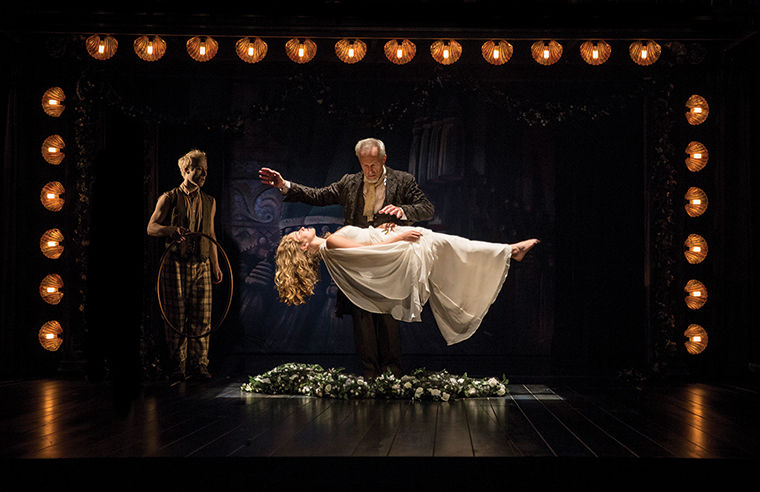‘The Tempest’ brings magic in Chicago
Courtesy Chicago Shakespeare Theater
Prospero levitates his daughter Miranda in Shakespeare Theater’s “The Tempest.”
September 14, 2015
Acclaimed director Aaron Posner’s rendition of Shakespeare’s haunting play “The Tempest” opened Sept. 8 at Chicago Shakespeare Theater’s Courtyard stage, 800 E. Grand Ave.
According to Regina Buccola, scholar-in-residence at Chicago Shakespeare Theater and chair of literature and languages at Roosevelt University, the play centers on Prospero, a “magus” who, after being exiled from Italy, uses magic to conjure disarray, including the titular tempest.
After this production originally premiered at the American Repertory Theater in Massachusetts, it made its way to the Chicago Shakespeare Theater stage following successful stints in Boston, Las Vegas and Costa Mesa, California.
The show was adapted by Posner and world-famous magician Teller, of duo Penn and Teller, and Christopher James Rose, assistant magic designer and long-time collaborator with Teller, said Chicago Shakespeare’s “The Tempest” is the best production their collective has ever put on.
Rose said a challenge with incorporating magic into the show is discerning which tricks enhanced the show without distracting from the storyline.
“Of the roughly 20 fabulous magic tricks they’re seeing, there [are] about 20 that they’re not seeing—they didn’t drive the plot forward,” Rose said.
The tricks included must not only drive the plot forward, but they also must embody a wide array of emotions, Rose said.
“Most magic shows that you see, the emotion is happiness, excitement, thrill. What we’re doing is giving you an entire emotional roller coaster ride. There are things that are funny and things that are creepy,” Rose said.
With magic integral to the play, from the namesake storm to haunting visions, Rose said it is only natural to use real magic instead of stage craft to make the audience feel “the same bewilderment the characters are [feeling].”
Among the star-studded credits in the play is singer/songwriter Tom Waits, who composed the music for the production with wife Kathleen Brennan.
Bethany Thomas, a musician who performs with the ensemble Rough Magic, said the percussion-heavy instrumentation of the music underscores what the audiences sees and experiences throughout the play.
Rough Magic is made up of four members who alternate between about 60 instruments that include xylophones, vibraphones and other “jangly” instruments, Thomas said.
Much like how the magic makes patrons feel a variety of emotions, Thomas said the unique instrumentation and open-minded production has led to changes and adaptations throughout the rehearsal process to lead viewers on an emotional journey.
“We’ve had songs where the feel kind of changed,” Thomas said.
With these elements, the show captures Chicago Shakespeare Theater’s vision that “Shakespeare speaks to everyone,” and that Shakespeare is a genius storyteller, the troupe’s site noted.
The Chicago Shakespeare Theater’s vision of creating a modern and approachable production has led it to become a “global theatrical force” according to their website. As for “The Tempest,” the theater is expecting success of supernatural proportions.








